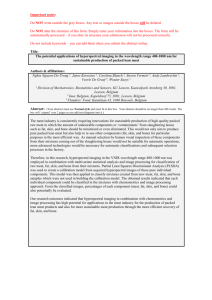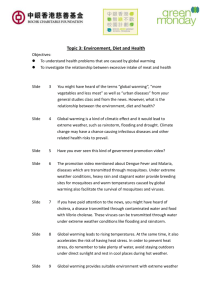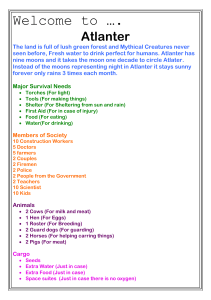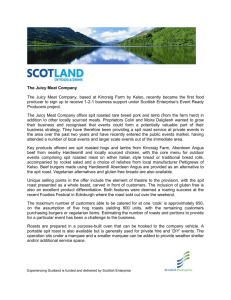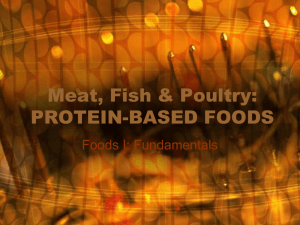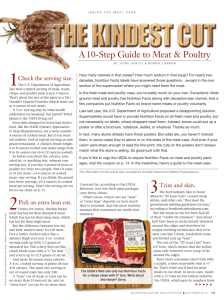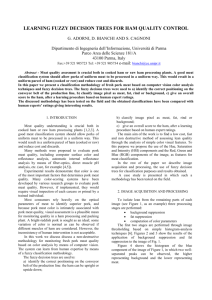2008 San Antonio FFA Meat Judging Contest Written Test February
advertisement
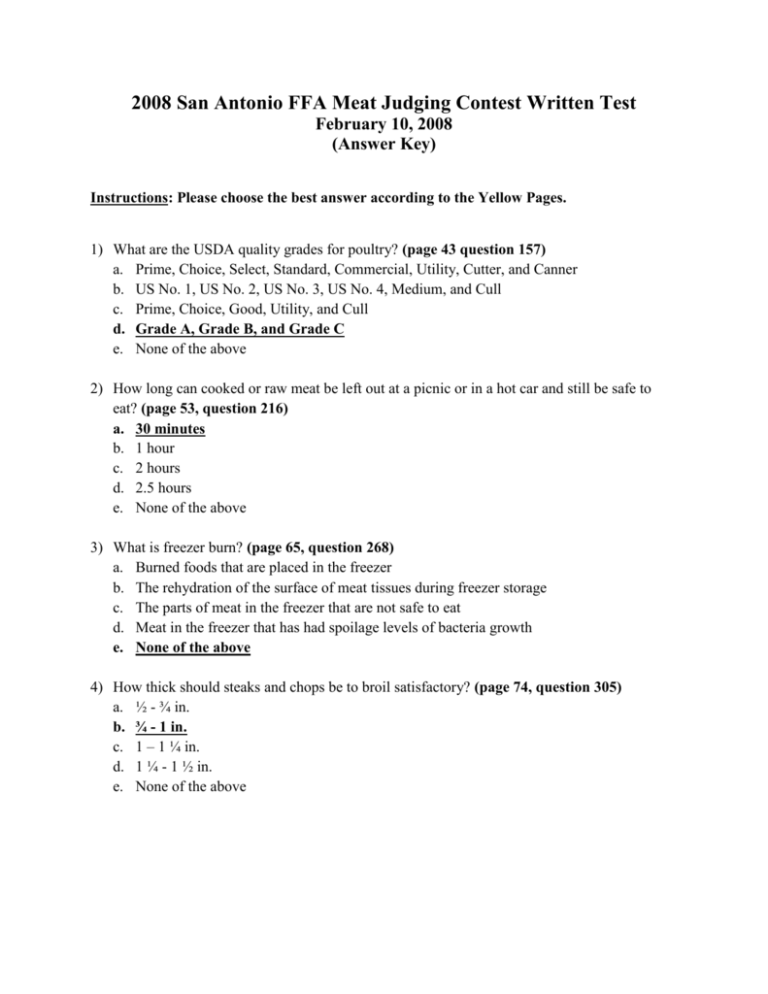
2008 San Antonio FFA Meat Judging Contest Written Test February 10, 2008 (Answer Key) Instructions: Please choose the best answer according to the Yellow Pages. 1) What are the USDA quality grades for poultry? (page 43 question 157) a. Prime, Choice, Select, Standard, Commercial, Utility, Cutter, and Canner b. US No. 1, US No. 2, US No. 3, US No. 4, Medium, and Cull c. Prime, Choice, Good, Utility, and Cull d. Grade A, Grade B, and Grade C e. None of the above 2) How long can cooked or raw meat be left out at a picnic or in a hot car and still be safe to eat? (page 53, question 216) a. 30 minutes b. 1 hour c. 2 hours d. 2.5 hours e. None of the above 3) What is freezer burn? (page 65, question 268) a. Burned foods that are placed in the freezer b. The rehydration of the surface of meat tissues during freezer storage c. The parts of meat in the freezer that are not safe to eat d. Meat in the freezer that has had spoilage levels of bacteria growth e. None of the above 4) How thick should steaks and chops be to broil satisfactory? (page 74, question 305) a. ½ - ¾ in. b. ¾ - 1 in. c. 1 – 1 ¼ in. d. 1 ¼ - 1 ½ in. e. None of the above 5) What is the difference between a half ham and a portion such as a shank portion or rump portion? (page 50, question 195) a. There is no difference b. A ham portion has had no center slices removed c. A ham portion has had center slices removed d. A ham portion actually comes from the shoulder, not the ham e. None of the above 6) What common foodborne bacteria was first found in chocolate milk in the United States? (page 58, question 237) a. Yersinia enterocolitica b. Escherichia coli c. Clostridium botulinum d. Campylobacter jejuni e. None of the above 7) How long are frozen foods safe to eat? (page 64, question 266) a. No longer than 1 year b. No longer than 5 years c. Depends on what cut it is d. As long as the foods remain frozen, they are safe e. None of the above 8) For best quality, what is the recommended storage time in a freezer, 0oF or colder, for whole poultry? (page 64, question 266) a. 1 year b. 2 years c. 2.5 years d. 3 years e. None of the above 9) How does the lean to fat ratio in ground beef affect the price? (page 47, question 178) a. The more fat and the less lean the higher the price b. The less lean and the more fat the higher the price c. The less fat and the more lean the lower the price d. The lean to fat ratio has no effect on price e. None of the above 10) Why do chuck steaks and shoulder chops buckle or curl when broiled? (page 89, question 388) a. Because of excessive moisture loss in the cooking process b. Because of shrinkage of the connective tissue membrane surrounding the muscle c. Because these cuts are tougher than other commonly used cuts d. Because broiling is a dry heat method of cookery e. None of the above 11) To what internal temperature should veal cuts used for roasting be cooked to? (page 93, question 93) a. 140oF b. 150oF c. 160oF d. 170oF e. None of the above 12) When pork is cooked by dry heat, what gas that is sometimes present in heating and exhaust gases may cause red areas in some well done pork? (page 90, question 391) a. Carbon monoxide b. Carbon dioxide c. Nitrogen d. Methane e. None of the above 13) What percentage of beef in the United States grades USDA Prime? (page 44, question 163) a. 2.5% b. 3.0% c. 3.5% d. 4.0% e. None of the above 14) What is a lamb crown roast? (page 93, question 411) a. The roast taken from the crown of the head of a lamb b. Two rib roasts sewed together to form a circle or crown c. A frenched lamb rib roast d. Two loin roasts sewed together to form a circle or crown e. None of the above 15) Research has shown that the trichinae parasite is killed at what temperature? (page 92, question 403) a. 140oF b. 150oF c. 160oF d. 170oF e. None of the above 16) Why is there a problem getting meat to brown in a microwave oven? (page 86, question 366) a. Because microwaves cook with hot air instead of cool air b. Because microwaves utilize moist heat cookery c. Because microwaves cook with cool air instead of warm air d. Because microwaves utilize dry heat cookery e. None of the above 17) What is the best method for knowing when a roast is done? (page 77, question 328) a. Use a roasting schedule b. Use a meat thermometer c. Cut a slit into the roast d. Use the oven’s thermostat e. None of the above 18) At what temperature should the fat be for deep fat frying? (page 75, question 312) a. 340-350oF b. 350-360oF c. 360-370oF d. 370-380oF e. None of the above 19) What common foodborne bacteria was recognized as a human foodborne illness after a 1981 Canadian outbreak traced back to contaminated coleslaw? (page 58, question 237) a. Escherichia coli b. Clostridium perfringens c. Salmonella enteritidis d. Yersinia enterocolitica e. None of the above 20) Who should you call to lodge a complaint about contaminated restaurant food? (page 59, question 241) a. USDA b. National Restaurant Association c. Local, state, or county health department d. FDA e. None of the above 21) What fruit does bromelin come from? (page 51, question 201) a. Fig b. Raspberry c. Papaya d. Coconut e. None of the above 22) What amount of fat is allowed in fabricated steaks? (page 48, question 183) a. 0% b. 20% c. 30% d. 35% e. None of the above 23) What does ground chicken contain? (page 48, question 181) a. Leg meat of chicken and the skin covering it b. Breast meat of chicken and the skin covering it c. Leg and thigh meat of chicken and the skin covering it d. All meat from the chicken and no skin e. None of the above 24) What is the recommended storage time in the refrigerator at 36oF to 40oF for broth or gravy? (page 62, question 262) a. 1 to 2 days b. 3 to 4 days c. 3 to 5 days d. 1 week e. None of the above 25) How long would it take to defrost poultry parts in the refrigerator at 36oF to 40oF? (page 66, question 276) a. 12 to 14 hours b. 4 to 7 hours per lb c. 3 to 5 hours per lb d. 1 day per 4 to 5 lbs e. None of the above

